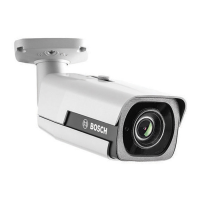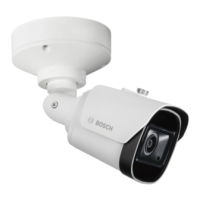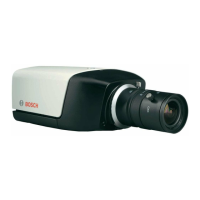DINION inteox 7100i IR | FLEXIDOME inteox 7100i Configuration | en 39
Bosch Security Systems B.V.
User manual
2021-08 | V01 | DOC
Automatic address
Displays the automatic address.
Prefix length
Enter the appropriate prefix length for the set IP address.
Gateway address
For the device to establish a connection to a remote location in a different subnet, enter the IP
address of the gateway here. Otherwise, this field can remain empty (0.0.0.0).
DNS server address 1/DNS server address 2
The device is easier to access if it is listed on a DNS server. For example, to establish an
Internet connection to the camera, it is sufficient to enter the name given to the device on the
DNS server as a URL in the browser. Enter the DNS server's IP address. Servers are supported
for secure and dynamic DNS.
Video transmission
If the device is used behind a firewall, TCP (HTTP port) should be selected as the transmission
protocol. For use in a local network, choose UDP.
Multicast operation is only possible with the UDP protocol. The TCP protocol does not
support multicast connections.
TCP rate control
Select On if you want to allow Adaptive Bit Rate encoding.
HTTP browser port
Select a different HTTP browser port from the list if required. The default HTTP port is 80. To
limit connection to HTTPS, deactivate the HTTP port. To do this, activate the Off option.
HTTPS browser port
To limit browser access to encrypted connections, choose an HTTPS port from the list. The
standard HTTPS port is 443.
The camera uses the TLS 1.0 protocol. Ensure that the browser has been configured to
support this protocol. Also ensure that Java application support is activated (in the Java Plug-
in Control Panel of the Windows Control Panel).
To limit connections to SSL encryption, set the Off option in the HTTP browser port and the
RCP+ port. This deactivates all unencrypted connections allowing connections on the HTTPS
port only.
Minimum TLS version
Select the version for minimum Transport Layer Security (TLS).
Allow HTTP basic authentication
Select On if you want to allow HTTP basic authentication. This is a less secure authentication
option where passwords are transmitted in clear text. This option should only be used if the
network and system are otherwise secured.
HSTS
Select this option to use the web security policy HTTP Strict Transport Security (HSTS) to
provide secure connections.
RCP+ port 1756
Activating RCP+ port 1756 allows unencrypted connections on this port. To allow only
encrypted connections, set the Off option to deactivate the port.
Discovery port (0 = Off)
Enter the number of the port that you want to discover.
To deactivate the port, enter 0.

